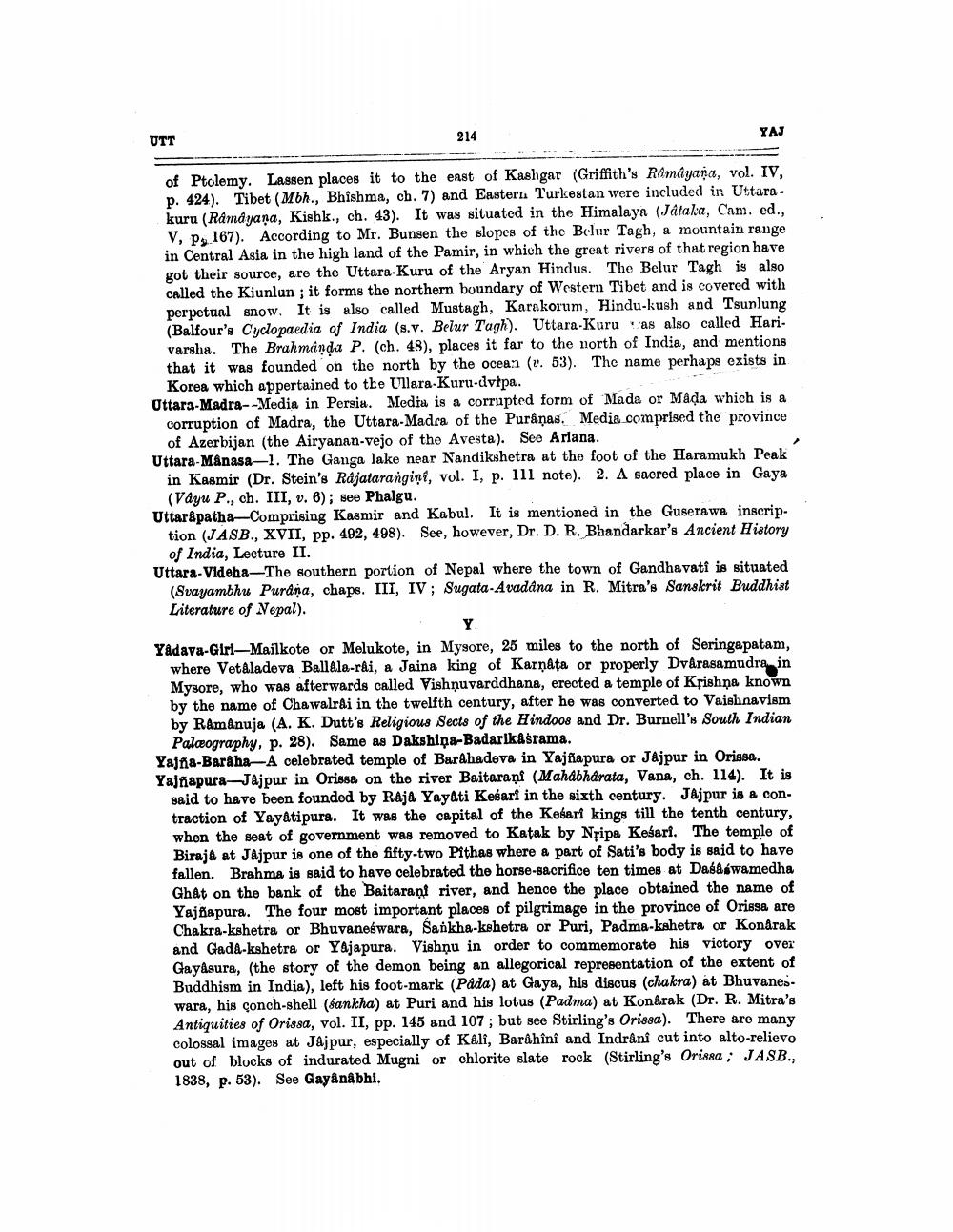________________
UTT
214
YAJ
of Ptolemy. Lassen places it to the east of Kashgar (Griffith's Rêmáyana, vol. IV, p. 424). Tibet (Mbh., Bhishma, ch. 7) and Eastern Turkestan were included in Uttarakuru (Ramayana, Kishk., ch. 43). It was situated in the Himalaya (Jataka, Cam. ed., V, P 167). According to Mr. Bunsen the slopes of the Belur Tagh, a mountain range in Central Asia in the high land of the Pamir, in which the great rivers of that region have got their source, are the Uttara-Kuru of the Aryan Hindus. The Belur Tagh is also called the Kiunlun; it forms the northern boundary of Western Tibet and is covered with perpetual snow. It is also called Mustagh, Karakorum, Hindu-kush and Tsunlung (Balfour's Cyclopaedia of India (s.v. Belur Tagh). Uttara-Kuruas also called Harivarsha. The Brahmanda P. (ch. 48), places it far to the north of India, and mentions that it was founded on the north by the ocean (v. 53). The name perhaps exists in Korea which appertained to the Ullara-Kuru-dvtpa.
Uttara-Madra--Media in Persia. Media is a corrupted form of Mada or Mada which is a corruption of Madra, the Uttara-Madra of the Purâņas. Media comprised the province of Azerbijan (the Airyanan-vejo of the Avesta). See Ariana.
Uttara-Mânasa-1. The Ganga lake near Nandikshetra at the foot of the Haramukh Peak in Kasmir (Dr. Stein's Rajatarangini, vol. I, p. 111 note). 2. A sacred place in Gaya (Vayu P., ch. III, v. 6); see Phalgu.
Uttarapatha-Comprising Kasmir and Kabul. It is mentioned in the Guserawa inscription (JASB., XVII, pp. 492, 498). See, however, Dr. D. R. Bhandarkar's Ancient History of India, Lecture II. Uttara-Videha-The southern portion of Nepal where the town of Gandhavati is situated (Svayambhu Purana, chaps. III, IV; Sugata-Avadana in R. Mitra's Sanskrit Buddhist Literature of Nepal).
Y.
Yadava-Girl-Mailkote or Melukote, in Mysore, 25 miles to the north of Seringapatam, where Vetaladeva Ballala-râi, a Jaina king of Karnata or properly Dvarasamudra in Mysore, who was afterwards called Vishnuvarddhana, erected a temple of Krishna known by the name of Chawalrâi in the twelfth century, after he was converted to Vaishnavism by Ramanuja (A. K. Dutt's Religious Sects of the Hindoos and Dr. Burnell's South Indian Palæography, p. 28). Same as Dakshina-Badarikasrama.
Yajña-Baraha-A celebrated temple of Barahadeva in Yajñiapura or Jajpur in Orissa. Yajnapura Jajpur in Orissa on the river Baitarani (Mahabharata, Vana, ch. 114). It is said to have been founded by Raja Yayati Kesari in the sixth century. Jajpur is a contraction of Yayatipura. It was the capital of the Kesari kings till the tenth century, when the seat of government was removed to Katak by Nripa Kesari. The temple of Biraja at Jajpur is one of the fifty-two Pithas where a part of Sati's body is said to have fallen. Brahma is said to have celebrated the horse-sacrifice ten times at Dasaswamedha Ghat on the bank of the Baitarant river, and hence the place obtained the name of Yajapura. The four most important places of pilgrimage in the province of Orissa are Chakra-kshetra or Bhuvaneswara, Sankha-kshetra or Puri, Padma-kshetra or Konârak and Gada-kshetra or Yajapura. Vishnu in order to commemorate his victory over Gayasura, (the story of the demon being an allegorical representation of the extent of Buddhism in India), left his foot-mark (Pada) at Gaya, his discus (chakra) at Bhuvaneswara, his conch-shell (sankha) at Puri and his lotus (Padma) at Konarak (Dr. R. Mitra's Antiquities of Orissa, vol. II, pp. 145 and 107; but see Stirling's Orissa). There are many colossal images at Jajpur, especially of Kâlî, Barâhînî and Indrânî cut into alto-relievo out of blocks of indurated Mugni or chlorite slate rock (Stirling's Orissa; JASB., 1838, p. 53). See Gayânâbhi.




